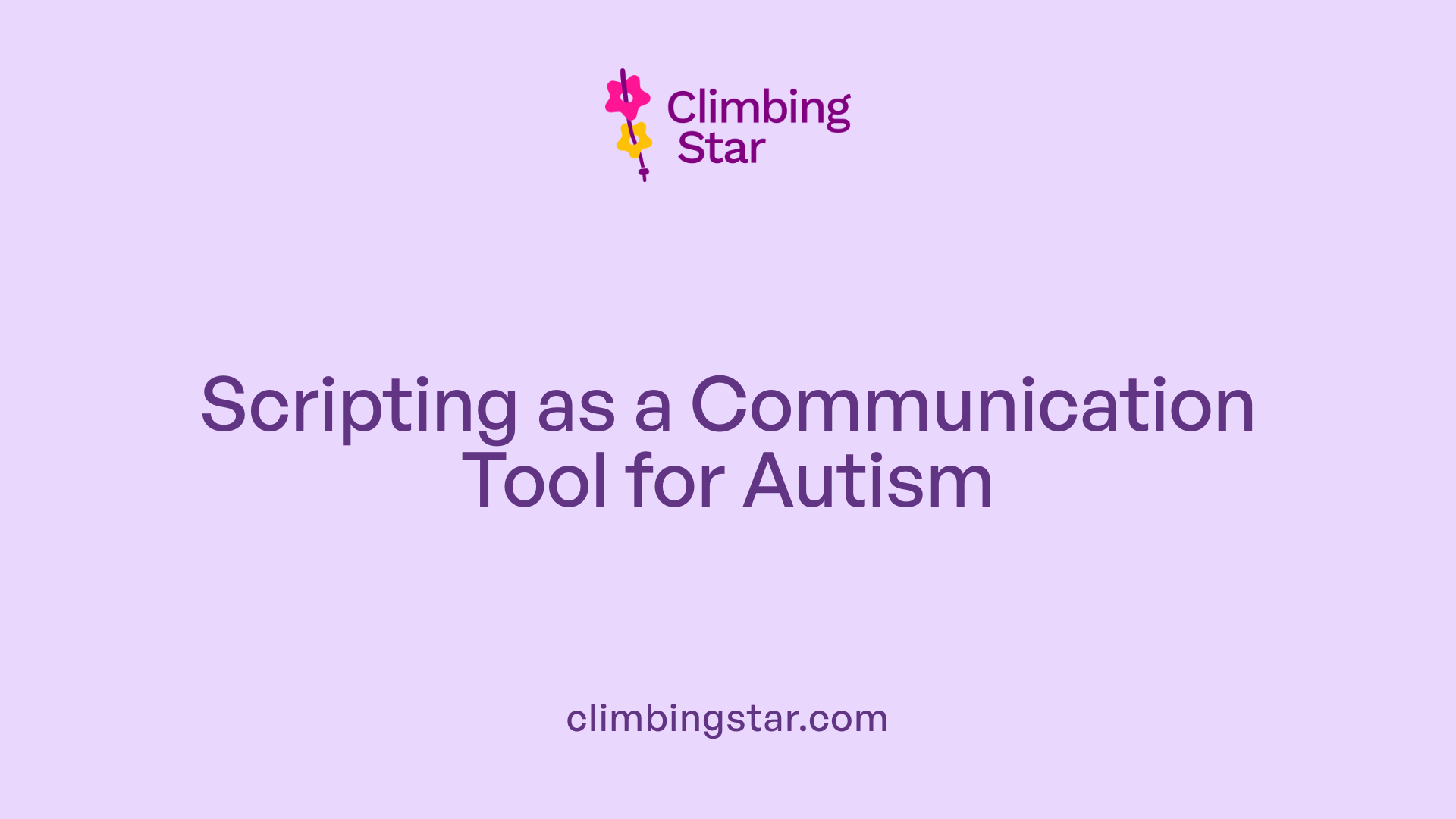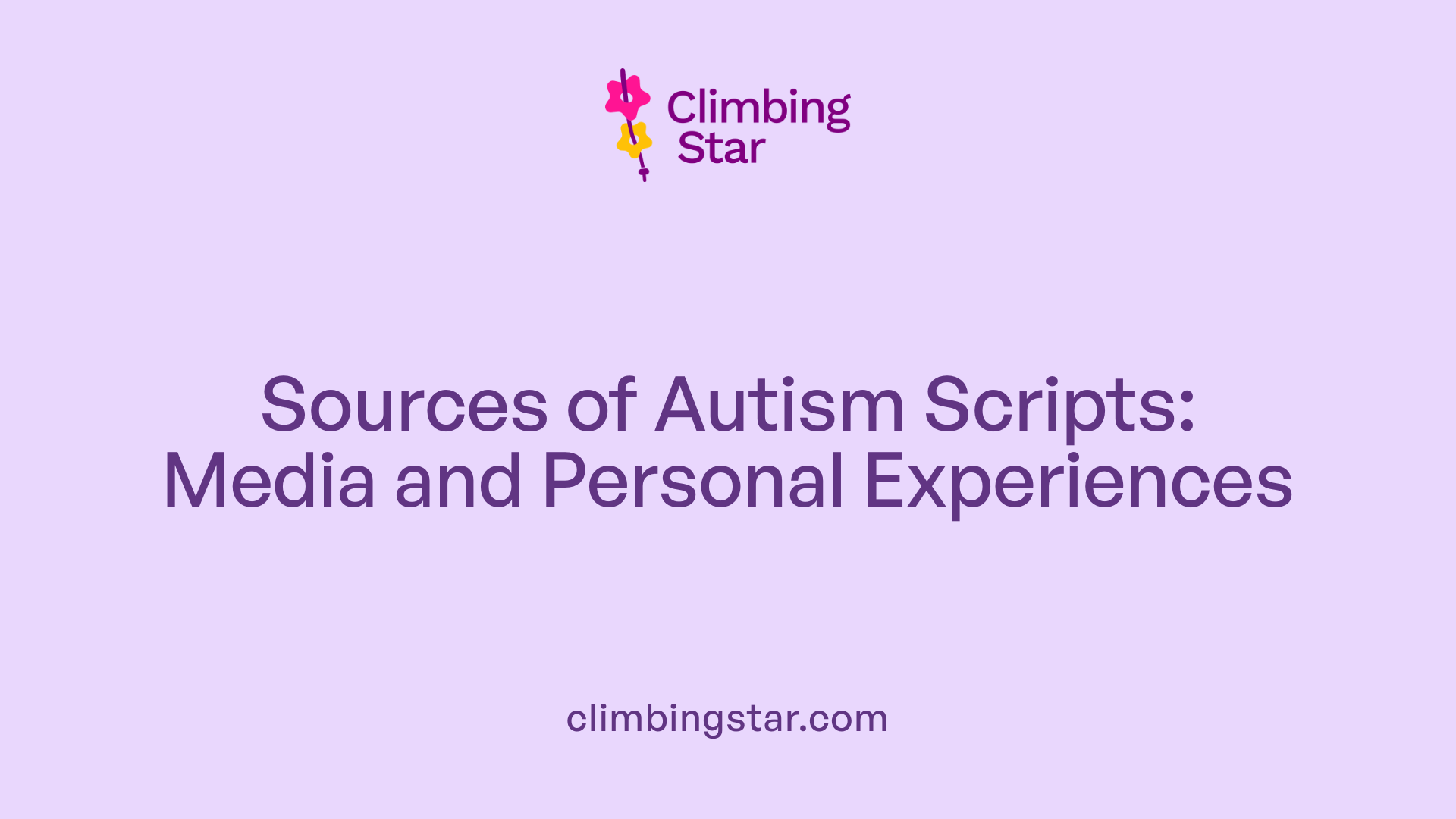Introducing Autism Scripting
Autism scripting is a distinct pattern of communication used by many individuals on the autism spectrum, involving the repetition of words, phrases, or even entire conversations learned from media or daily interactions. Far from meaningless repetition, scripting serves multiple functions, including self-expression, emotional regulation, and social connection. This article explores what autism scripting is, how it manifests, and the vital role therapies like Applied Behavior Analysis (ABA) play in supporting positive communication development.
Defining Autism Scripting and Its Forms

What is autism scripting?
Autism scripting is the repetitive use of words, phrases, or dialogues learned from various sources such as TV shows, movies, books, or everyday conversations. This behavior involves repeating language patterns that an autistic individual has absorbed from their environment rather than generating spontaneous speech.
Forms of scripting including echolalia
There are different forms of scripting that autistic individuals may exhibit. A common form is echolalia, which comes in two types:
- Immediate echolalia: Repeating phrases or sentences right after hearing them.
- Delayed echolalia: Repeating phrases after a time delay, sometimes from past experiences or media exposure.
Besides echolalia, scripting also includes personal scripts—phrases and dialogues based on an individual’s own experiences and interests. These scripted lines can be extensive and context-specific, reflecting the person’s unique way of communicating.
Sources of scripts such as media and personal experience
Scripts often originate from media like TV shows, movies, and books, offering familiar and comforting language patterns. These media-inspired scripts provide a sense of structure and predictability. Additionally, autistic individuals might use personal experience scripts derived from real-life interactions or observations. These help them navigate social situations and express themselves more confidently.
Through these forms and sources, autism scripting serves as a communication tool that aids many autistic individuals in expressing thoughts, managing emotions, and connecting with the world around them.
How Scripting Functions as Communication

How does scripting serve individuals with autism?
Scripting functions as a vital form of communication for many autistic individuals. By repeating words, phrases, or entire conversations gleaned from media, books, or daily interactions, scripting allows for self-expression when traditional speech may be challenging. These familiar language patterns help to initiate and maintain conversations, providing a foundation for social connection.
Scripting as a communication tool
Scripting is not just repetition; it is a meaningful communication strategy. It can take forms such as immediate echolalia (repeating phrases right away) or delayed echolalia (repeating phrases later). Through scripting, individuals express interests, preferences, and thoughts in ways that are accessible and comfortable for them. This tool often serves non-verbal or minimally verbal individuals by supplementing communication through gestures, sign language, or augmentative devices.
Emotional regulation via scripting
In situations of stress or sensory overload, scripting offers predictability and comfort. The familiar scripts create a sense of control when environments feel chaotic. This mechanism supports emotional regulation by reducing anxiety and providing a soothing structure.
Building social interaction skills
Scripting also plays a crucial role in developing social skills. By using learned scripts, individuals can engage in conversations with more confidence and clarity. Therapies such as Applied Behavior Analysis (ABA) often incorporate scripting techniques to enhance social understanding and reduce anxiety, encouraging the gradual shift toward spontaneous and flexible communication.
| Aspect | Description | Benefits |
|---|---|---|
| Scripting as Communication | Repetition of learned phrases from media or life to express oneself | Enables self-expression and social connection |
| Emotional Regulation | Using familiar scripts during stress or sensory overload | Provides comfort and reduces anxiety |
| Social Interaction Skills | Practicing scripts to engage in conversations and social situations | Builds confidence and promotes communication |
This multifaceted approach highlights scripting as a powerful bridge toward enhancing communication and social interaction for autistic individuals.
Immediate and Delayed Echolalia Explained

What Is Immediate Echolalia?
Immediate echolalia occurs when an individual with autism repeats words or phrases right after hearing them. For example, if someone says "Do you want juice?", the person might immediately echo, "Do you want juice?" This rapid repetition helps process language and can serve as an initial step in communication.
Understanding Delayed Echolalia
Delayed echolalia involves repeating phrases or sentences after a period of time has passed—sometimes hours or days following the original hearing. These repetitions might come from TV shows, movies, or conversations the individual was exposed to earlier. A child might respond to a question with a line heard in a favorite movie rather than using spontaneous speech.
How Do Immediate and Delayed Echolalia Differ?
| Echolalia Type | Timing of Repetition | Typical Use or Context |
|---|---|---|
| Immediate Echolalia | Right after hearing a phrase | Helps with immediate understanding and emotional regulation |
| Delayed Echolalia | After a delay, sometimes long after original exposure | Often based on media or previous conversations; can express needs or emotions |
Both types are important communication tools for many autistic individuals. Immediate echolalia can help them process language instantly, while delayed echolalia allows use of familiar, comforting phrases for expression or managing stress. Understanding these forms can aid caregivers and therapists in supporting positive communication development.
Sources and Types of Scripts Used by Individuals with Autism

Media-Inspired Scripts
Many individuals with autism develop scripting behaviors by repeating language from movies, TV shows, books, and other media. These scripts often consist of memorized phrases, dialogues, or entire scenes that provide comfort and predictability. Such media-inspired scripts reflect personal interests and help create a familiar foundation for social communication.
Personal Experience Scripts
Apart from media, individuals may also develop scripts based on their daily life and personal experiences. These personal experience scripts include language or phrases from real-life interactions, observations, or routines. They help individuals navigate social situations by providing familiar language patterns derived from their unique environment.
Observing Social Language Patterns
Creating scripted dialogue often involves observing how typically developing individuals use language in social settings. Autistic individuals learn social cues and conversational norms through this observation, which shapes the scripts they later use. This process helps bridge the gap between learned language and real-world social interactions, facilitating more confident communication.
Together, these sources contribute to the diverse repertoire of scripts used by autistic individuals to support communication, build social skills, and manage interaction challenges.
The Role of Autism Scripting in Providing Comfort and Predictability

How does scripting help in sensory-overload situations?
Autism scripting acts as a comforting strategy during sensory-overloaded or stressful scenarios. For many autistic individuals, overwhelming stimuli can cause heightened anxiety and discomfort. By repeating familiar phrases or lines from media or personal experiences, scripting creates a mental refuge that helps manage sensory input and emotional stress.
In what ways does scripting create predictable environments?
Scripting uses pre-learned language patterns, whether from television, movies, or daily conversations, to bring a sense of order to unpredictable social settings. This predictability helps individuals anticipate what to expect and how to respond, thus reducing uncertainty. The repetitive nature of scripting contributes to a stable framework that feels safe and controlled.
How does scripting assist with emotional and anxiety management?
Through repetitive language, scripting serves as a self-regulation tool. It provides a consistent and reliable form of communication that can soothe and distract from anxiety or emotional upheaval. Scripting also empowers individuals by offering familiar dialogue they can use to express feelings or connect socially, which might otherwise be challenging. This leads to reduced stress and promotes emotional comfort.
Together, these functions highlight scripting as more than mere repetition—it is an adaptive mechanism supporting emotional well-being and social navigation by fostering comfort and predictability during challenging moments.
Applied Behavior Analysis (ABA) Therapy: An Overview
What is ABA therapy?
Applied Behavior Analysis (ABA) therapy is a scientifically supported treatment aimed at understanding and modifying behavior through learning principles. This approach focuses on increasing beneficial skills such as communication, social interaction, and self-care. It also helps reduce harmful or disruptive behaviors by applying strategies like positive reinforcement. ABA programs are tailored to each individual’s unique needs and are typically overseen by trained professionals, such as Board Certified Behavior Analysts (BCBAs).
Goals and methods
The primary goals of ABA therapy include enhancing social communication, developing daily living skills, and fostering independence. Methods used in ABA consist of techniques such as Discrete Trial Training (DTT), social skills training, and scripting to promote functional language and social behaviors. Importantly, scripting techniques in ABA help individuals with autism initiate and participate in conversations by using prepared phrases, which can gradually lead to more spontaneous communication.
Settings and professionals involved
ABA therapy is delivered in various settings including homes, schools, clinics, and community environments. The therapy team often consists of Board Certified Behavior Analysts (BCBAs), registered behavior technicians (RBTs), speech therapists, and family members collaborating to support the individual. Through consistent assessment and personalized intervention plans, these professionals work together to improve quality of life and social function for autistic individuals.
How Behavioral Analysis Supports Autism Scripting and Communication Development
How does behavioral analysis support individuals with autism?
Behavioral analysis, especially Applied Behavior Analysis (ABA), plays a crucial role in supporting individuals with autism by using scientific methods to understand and shape behaviors. ABA uses methods like positive reinforcement to encourage desirable communication and social interactions.
ABA strategies incorporating scripting
ABA therapy often includes scripting techniques where individuals learn and practice specific scripts for social situations. These scripts, drawn from media or real-life interactions, help build social skills by providing predictable language patterns. Through systematic teaching—such as Discrete Trial Training—individuals practice scripts until they can use them confidently in everyday settings.
Positive reinforcement in scripting
Positive reinforcement is essential in ABA to encourage the use of appropriate scripts. When autistic individuals successfully use scripts to communicate or interact socially, therapists respond with praise or rewards. This reinforcement strengthens the behavior, increasing motivation and helping reduce anxiety associated with social exchange.
Enhancing spontaneous communication
While scripting serves as a beneficial stepping stone, ABA emphasizes gradually promoting spontaneous and flexible communication. Therapists work on fading scripts, encouraging the individual to create original language and adapt conversations depending on the context. This balance helps expand communication skills beyond the reliance on scripted language, fostering independence and varied social engagement.
These ABA practices make scripting an effective tool for improving language, social connections, and emotional regulation among autistic individuals, ultimately aiming toward more natural and versatile communication.
Who Provides ABA Therapy and Behavioral Analysis Services?
Professionals Involved in ABA Therapy
ABA therapy and behavioral analysis services are delivered by a team of specialized professionals trained to support individuals with autism and related developmental disorders. Key providers include Board Certified Behavior Analysts (BCBAs), Board Certified Assistant Behavior Analysts (BCaBAs), and Registered Behavior Technicians (RBTs).
Roles of BCBAs, BCaBAs, and RBTs
- BCBAs are expert clinicians who assess individuals, develop tailored treatment plans, and oversee therapy programs. They ensure that interventions are evidence-based and adapted to meet each person's unique needs.
- BCaBAs support BCBAs by assisting in the implementation and monitoring of treatment plans under supervision, often providing direct intervention.
- RBTs are frontline providers who directly work with clients to implement therapy sessions following structured plans. They gather data and provide feedback to the supervisory team.
Collaboration with Other Specialists
ABA professionals work collaboratively with other healthcare providers such as licensed psychologists, psychiatrists, speech therapists, occupational therapists, and developmental pediatricians to provide a holistic approach. This multidisciplinary team ensures comprehensive support addressing behavioral, communication, emotional, and developmental goals.
Together, these professionals provide a coordinated, individualized, and scientifically grounded approach in delivering effective ABA and behavioral analysis services to improve social, communication, and life skills.
Benefits of ABA Therapy for Individuals Who Use Scripting
How Does ABA Therapy Improve Social Interaction Skills?
ABA (Applied Behavior Analysis) therapy uses structured scripting techniques to teach autistic individuals how to initiate and participate in social interactions. By practicing specific social scripts, individuals gain confidence in conversations and learn appropriate responses for various situations. This repeated practice helps build essential social skills and allows autistic learners to navigate social settings with greater ease.
Can Structured Scripting Reduce Anxiety?
Scripting in ABA therapy provides a predictable and familiar framework that helps reduce anxiety for autistic individuals. When faced with stressful or sensory-overloaded situations, having a scripted dialogue to rely on creates a sense of control and comfort. This structured approach lessens the unpredictability of social interactions and makes them less overwhelming.
In What Ways Does ABA Enhance Communication and Independence?
ABA therapy promotes the development of varied and spontaneous communication beyond just scripted language. While initial reliance on scripts supports expression and understanding, therapy encourages expanding communication to include original thoughts and flexible language use. This progression helps individuals gain independence in social settings and daily life.
ABA therapy responds to each person's unique needs, using reinforcement and tailored instruction to foster improvements in communication, reduce anxiety, and encourage autonomy. Overall, it is an evidence-based practice that supports better quality of life for autistic individuals.*
| Benefit Area | Role of Scripting in ABA Therapy | Outcome for Individuals |
|---|---|---|
| Social Interaction Skills | Practice with specific scripts for common scenarios | Increased confidence and social participation |
| Anxiety Reduction | Provides predictability and comfort through scripts | Less stress in social and sensory situations |
| Communication & Independence | Encourages movement from scripted to spontaneous language | Enhanced self-expression and autonomy |
Strategies to Support Positive Autism Scripting Practices
Recognizing and Valuing Scripting as Communication
Scripting in autism should be understood as a valid form of communication rather than meaningless repetition. It provides individuals with a way to self-express, regulate emotions, and connect socially. Parents, teachers, and therapists are encouraged to acknowledge scripting as a meaningful skill, helping to build trust and open communication pathways.
Encouraging Flexible Language Use
While scripting offers comfort through familiar phrases, promoting flexible and spontaneous language is essential for developmental growth. Strategies include prompting choices rather than relying solely on scripts, narrating the child’s actions to model new language, and fostering ongoing conversations to encourage original thoughts. Gradually expanding communication beyond scripted lines helps individuals build confidence and diverse social skills.
Using Visual Supports and Augmentative Communication Devices
Incorporating visual supports and augmentative communication tools can enhance scripting’s effectiveness. Visual aids help clarify meaning and provide cues for alternative expressions, while devices such as speech-generating tools assist non-verbal or minimally verbal individuals in communicating more autonomously. These supports work synergistically with scripting, creating a structured yet adaptable environment for language development.
Promoting Spontaneous Communication Beyond Scripting
How Can Scripts Be Gradually Faded to Encourage Autonomy?
Gradual fading of scripts is an effective strategy to help individuals with autism shift from relying heavily on memorized language to more spontaneous communication. This process involves slowly reducing prompts and reliance on scripted phrases once the individual shows comfort and confidence in a given social situation. The goal is to allow natural language and flexible responses to emerge without eliminating the supportive structure that scripting provides initially.
What Techniques Encourage Original Thought and Personal Narratives?
Encouraging original thought involves fostering creativity and personal expression beyond repeated scripts. Helping children develop personal narratives can be achieved by systematically prompting them to describe their thoughts, feelings, and experiences in their own words. This practice nurtures self-generated language and gradually reduces dependence on external scripts derived from media or rote repetition.
How Do Prompting and Narrating Actions Support Communication Development?
Techniques like prompting choices and narrating the child's actions play important roles in moving away from scripted speech. Prompting choices invites the individual to make decisions about what to say or do next, helping them engage more actively and flexibly in conversations. Narrating actions provides real-time language modeling tied directly to the present context, giving children concrete examples of spontaneous communication to imitate.
By integrating these approaches, therapists, educators, and caregivers can support autistic individuals in expanding their communication skills. This balanced approach maintains the benefits scripting offers for emotional regulation and structure, while fostering independence and versatile language use for meaningful social interactions.
The Path Forward: Embracing and Supporting Autism Scripting
Autism scripting is far more than repetitive speech—it is a powerful communication tool that provides comfort, fosters social connection, and aids emotional regulation for many individuals on the spectrum. Understanding its forms and functions allows parents, educators, and therapists to support scripting positively, balancing it with strategies that encourage diversity and spontaneity in communication. Therapies like Applied Behavior Analysis play a crucial role in harnessing scripting's benefits while promoting growth toward meaningful, independent interactions. Embracing scripting with informed and compassionate approaches paves the way for enriched communication experiences and improved quality of life for autistic individuals.







